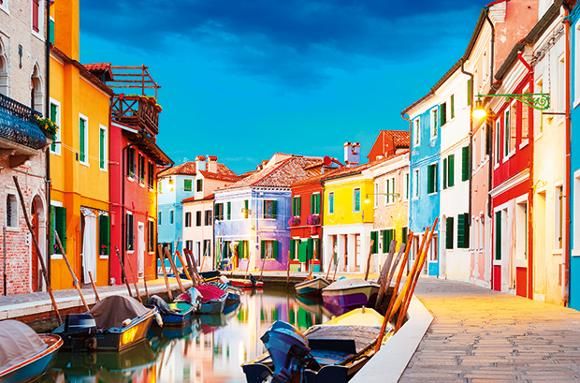
Famous for being sticky, sweaty and (some might even cruelly claim) smelly during the height of summer, Venice is rarely relieved by a cool breeze. That probably explains why Isola delle Rose, a 16-hectare island south of San Marco, has always been known to Venetians as a jewel in the lagoon.
With temperatures at a balmy 31°C, I welcome the salty Adriatic sea breeze billowing the muslin drapes on my rooftop daybed. Operating as a sanatorium in the 1920s, the island offered recuperation to patients with pulmonary diseases. The hospital has since been replaced by a hotel, although rest and recuperation are still high on the agenda.
Made from the sand and soil dug out during the construction of the city’s commercial port, Isola delle Rose is one of 35 islands in the Venetian Lagoon. While tourist hotspots such as Burano (famous for its colourful fishermen houses) and Murano (home to a world-renowned glass-blowing industry) are firmly on the map, other islands, which were once used to isolate plague victims, or even to house the insane in asylums, have been forgotten over time. Hoteliers, though, are starting to realise a hitherto missed opportunity. In March this year, JW Marriott Venice, a swish summer resort, opened on its own private island of Isola delle Rose. Operating from March to October, the hotel is set in the peaceful green grounds where century-old olive groves – quite unheard of this far north – flourish, thanks to the unique microclimate.
There are several seasonal hotels in Venice but this is a different concept; an escape from the summer madness that besets the city as cruiseliners deposit hordes of tourists in the narrow, labyrinthine streets.
While lazing in the rooftop infinity pool, I enjoy a clear, crowd-free view of Venice, or La Serenissima to locals. I’m told it’s even possible to see the faint outline of the Alps on a good day.
It took 350 workers four years to complete the 250-room hotel, restoring original 19th-century buildings wherever possible. I stay in the main wing, with cool, neutral interiors, designed by Milan-based Matteo Thun. A conveyor belt of visitors churns through the busy reception area – which at times feels even more manic than San Marco – and quirky touches, such as giant glass jars filled with complimentary jelly sweets, save the former hospital from feeling too clinical.
Outside the main building, several grain stores have been converted into garden villas, with private pools and trellises of fragrant jasmine. A pre-Romanesque church, although not consecrated, is available for event use, and an industrial water tower looks all-too-tempting to climb. Although it must have been a frustrating inconvenience for hotel planners, this protected piece of the Venetian skyline is, to my mind, a defining feature of Isola delle Rose. I wander through the shady 19th-century gardens, landscaped to an original design, listening to birdsong. When the hospital closed in the 1970s, the island was abandoned for decades, and the overgrown linden forests became a favourite picnic spot for Venetians sneaking over in private boats.
Today, they can still moor up alongside the hotel, although the food now on offer is of a much higher standard. Presided over by renowned chef Gianfranco Perbellini, the gourmet Dopolavoro restaurant is well worth the 20-minute boat ride from Venice, even if you’re not staying at the hotel. Once used as a social space by hospital workers (even the name, which means ‘after work’, is borrowed), the moody, mirror-filled restaurant is stirring up Venice’s somewhat stale culinary scene with creative dishes such as zabaglione topped with caviar.
There are three other restaurants to dine in – breakfast bar Cucina; relaxed Sagra, serving a rotating menu of regional cuisine; and al fresco grill Giardino. At the on-site Sapori Cooking Academy, I spend the afternoon with unfalteringly patient chef Matteo, learning the secret to a good tiramisu lies in a vat of mascarpone equivalent to a woman’s annual calorie count. Yet I still order the caffeine-kick dish (which Venetians like to claim as their own) for dessert. No less than twice a day I might add.
Never mind, there’s plenty of opportunity to burn off cream-induced fat at the gym, or just to cheat with a body-contouring treatment at the Goco garden spa, the largest in Venice, with its sauna, steam room and a hydro-pool looking out to the lagoon. (Access to facilities costs an extra €25 or Dh100.) I try a QMS facial (€169), where oxygen is blasted on to my skin, stamping pesky crows’ feet into submission, although less invasive treatments are available using the organic Amala range.
While Isola delle Rose’s trump card is its separation from Venice, it’s also the hotel’s main drawback. A regular 20-minute shuttle service runs to San Marco until 1am, but the 9am start is a little too late to avoid crowds.
However, that’s probably a concern for Venice first-timers who prefer to be in the thick of the action. Returning visitors will relish a chance to weave beyond bricole poles and delve further into the salt marshes, discovering new jewels in the regal city’s crown.
Take a detour to lesser-known islands in the Venetian Lagoon
San Servolo
Lying opposite Isola delle Rose, this island was inhabited by Benedictine monks from the eighth century. It was later used as a military hospital, and then a place to care for the mentally ill. It’s now home to Venice International University.
Explore the pretty gardens, filled with medicinal plants once used by the hospital and now functioning as an exhibition space for the Venice Biennale.
Entry is free, but the Insane Asylum Museum (open Friday to Sunday from May to September) costs €6 per person.
To get there, take the vaporetto line 20 (€7 one way) from San Zaccaria, close to San Marco (it’ll take about 10 minutes).
See www.sanservolo.provincia.venezia.it.
San Lazzaro degli Armeni
The next stop from San Servolo, en route to the Lido, this wonderful island belongs to an order of Armenian monks. Over the centuries, literary figures – including Lord Byron, who allegedly learned Armenian here in just six months – have flocked to this retreat.
Multilingual monks still conduct public tours daily at 3.30pm, visiting the church, refectory and library filled with precious books. Look out for interesting artefacts including an Egyptian mummy! Tickets for the tour cost €6.
The Republic of Armenia was recently named the national winner of the 56th Biennale, and the artwork is on display here until November 22. To get there, take the vaporetto line 20 from San Zaccaria, close to San Marco (about 13 minutes).
Call +39 (0)41 526 0104 for details.
Vignole
Dominated by poppy fields and allotments, this residential island is visited by Venetians seeking a sleepy afternoon in the cradle of nature. A public footpath leads to the remains of a seventh-century church, but continue over a bridge to the simple, waterfront Trattoria alle Vignole (open for lunch and dinner from mid-May to September), serving pizzas and seafood dishes (from €8).
Looking out to San Pietro di Castello, the first cathedral of Venice, it’s a great place to watch the sunset. Just beware of the pesky mosquitoes!
To get there, take the vaporetto line 13 from Fondamente Nove (20 minutes).
Call +39 (0)41 528 9707 for details.







